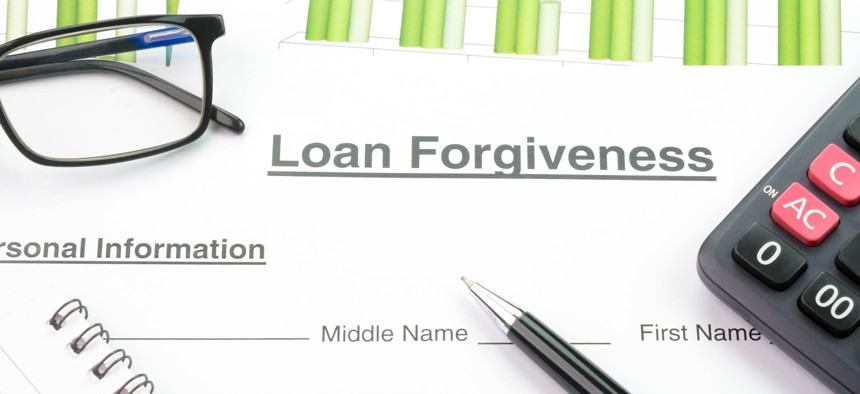Nonprofits
Commentary: Nonprofits should spread the word on little-known $10B federal student loan forgiveness for their employees
The program can help those eligible public service workers, but only until October.

jayk7 - Getty
I had a life-changing experience a few weeks ago. All of my remaining federal student debt was forgiven by the government, eliminating hundreds of future monthly payments.
This was only possible because of a little-known opportunity called the Public Service Loan Forgiveness program (PSLF) and an even lesser-known one-time modification that expires in October 2022. There are 250,000 New Yorkers, including many low-wage human services workers, who are likely eligible for the same program. If my fellow nonprofit and government leaders don’t act fast to spread the word, our colleagues may lose billions of dollars forever.
According to the New York City Department of Consumer Affairs, nearly 1 million New Yorkers have student loans, totalling nearly $35 billion. Most student loans are federal loans owed to the U.S. government under one of several loan programs.
In 2007 the federal government created the PSLF program with the promise that anyone could get their debt erased if they worked for a nonprofit or government agency for 10 years. In New York City we have approximately 250,000 public service workers who also have federal student debt: crossing guards and university professors, City Council aides and sanitation workers, teachers and foster agency staff.
The key to PSLF is making 120 “qualifying payments” on your loan while working in public service. To qualify in the past, loan payments had to be made of a very specific type – the right type of loan and the right type of payment plan. If you made 8 years of payments before realizing you were on the wrong payment plan, for example, too bad. The clock started and you still had 10 years of payments to go.
The original PSLF was so complicated and bureaucratic that almost no one actually received forgiveness. Despite millions theoretically eligible across the country, literally only 16,000 had received forgiveness by 2020. However in October 2021, the Department of Education introduced the PSLF waiver program which made significant changes. Millions of borrowers were newly eligible for immediate loan forgiveness – or at least to have years of payment credit newly added to their progress tracker. I went from having zero qualifying payments in my tracker to having 134.
Under the waiver, the program is much more flexible. Credit will be given for many more payments going back to 2007. In fact, the waiver instructs the government to give credit for any “payment period” in good standing - so even the past 2 years when all payments for all borrowers were suspended due to COVID can count as 24 qualifying payments toward the 120 goal.
Even better, the government will give you credit for whenever you should have reached the 120 mark. If you have made loan payments since then – they will actually refund your money. Since the government now agrees I made 134 qualifying payments – they refunded me my most recent 14.
So far, so good. But of course there’s one huge catch – this waiver only lasts until October 31, 2022. After that, the government is free to extend the waiver, or equally free to cancel the entire PSLF program. We are only guaranteed until October.
PSLF applications still seem complicated but are actually fairly straightforward. I found it harder than getting a library card, easier than doing my taxes. First and most urgently, all borrowers should check their status using the “Help Tool” at StudentAid.gov to see if they qualify. Then they may need to change their loan type, they will certainly need signatures from any nonprofit or government employers since 2007, and they need to submit a brief form to the government requesting forgiveness. The process will take several months, but it does seem to be happening properly now.
Despite the clear and massive opportunity for our nonprofit and government colleagues, there has been very little coordinated outreach to the New Yorkers who might need this help the most. Helping New Yorkers access this program is good for them, free money for our city’s economy, and a demonstration of care from nonprofit and government leaders.
City leaders including government officials, nonprofit executives and associations, labor unions, as well as the philanthropic and business community should immediately launch an outreach effort organized around three pillars:
100% Awareness: We must use all tools at our disposal (social media, staff meetings, multi-lingual campaigns) to make sure that every one of those 250,000 New Yorkers is aware of this opportunity, and has the necessary information, in time to get the work done by October 31.
100% Access: All employers have a role to play in making sure their part of the paperwork is accurately completed in a timely manner. Employers should consider pre-filling the relevant form for all employees and offering it affirmatively.
100% Follow-Up: Once our colleagues are aware and on the road, we must offer follow up support and tracking to help them cross the finish line. This can be done by the employer or even by a temporary “customer support” phone bank or through 311.
Imagine if Social Security existed, was going to expire in 5 months, and no one knew about it. I only became mobilized on this issue because of personal experience, but we can’t let more time elapse before we take action. The time to bring $10 billion to 250,000 New York City public service workers is now.
